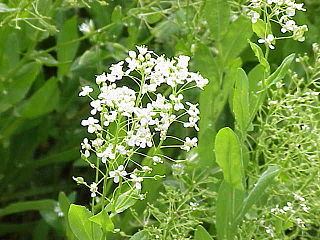
The River Wharfe is a river in Yorkshire, England. For much of its length it is the county boundary between West Yorkshire and North Yorkshire.

Quadrans Muralis was a constellation created by the French astronomer Jérôme Lalande in 1795. It depicted a wall-mounted quadrant with which he and his nephew Michel Lefrançois de Lalande had charted the celestial sphere, and was named Le Mural in the French atlas. It was between the constellations of Boötes and Draco, near the tail of Ursa Major, containing stars between β Bootis (Nekkar) and η Ursae Majoris (Alkaid).

Draba is a large genus of flowering plants in the family Brassicaceae, commonly known as whitlow-grasses.

Draba aizoides is a species of Draba, known as yellow whitlow-grass. It is native to Europe where it is found on limestone rocks and walls. In the British Isles it is found only on the Gower peninsula.

Lepidium draba, the whitetop or hoary cress, or Thanet cress, is a rhizomatous perennial flowering plant in the family Brassicaceae. It is native to western Asia and southeastern Europe and widely introduced elsewhere.
NVC community CG10 is one of the calcicolous grassland communities in the British National Vegetation Classification system. Of the upland group of calcicolous grasslands, it is the only one with a short sward associated with heavy grazing.

British NVC community OV42 is one of the open habitat communities in the British National Vegetation Classification system. It is one of six communities of crevice, scree and spoil vegetation.
British NVC community OV41 is one of the open habitat communities in the British National Vegetation Classification system. It is one of six communities of crevice, scree and spoil vegetation.

Cymbalaria muralis, with common names ivy-leaved toadflax, Kenilworth ivy, coliseum ivy, Oxford ivy, mother of thousands, pennywort, wandering sailor, is a flowering plant in the family Plantaginaceae native to Mediterranean Europe and widely naturalised elsewhere.

Draba verna the spring draba, shadflower, nailwort, common whitlowgrass, vernal whitlow grass, early witlow grass or whitlow-grass is a species of plant in the mustard family, Brassicaceae. D. verna has the unique trait of bifid petals, not found anywhere else in the genus Draba. The plant consists of a few flowers with branching stems and the leaves are focused around the base of the plant. The seeds are located in the flower but are not equipped with any sort of wind dispersal adaptation.

Diplotaxis muralis, the annual wall-rocket, is a species of flowering plant in the family Brassicaceae. This plant is native to Europe, Asia, and Africa, but it is found throughout the temperate world, where it has naturalized. This is an erect mustard-like plant rarely reaching half a meter in height. It has lobed leaves and its stems are topped with dense inflorescences of yellow, or occasionally light purple, flowers with small oval petals and large anthers. The fruit is a podlike silique two to four centimeters long.
NVC community CG1 is one of the calcicolous grassland communities in the British National Vegetation Classification system. It is one of three short-sward communities associated with heavy grazing, within the lowland calcicolous grassland group, and is regarded as the south-west coastal counterpart of "typical" chalk grassland.

Lactuca muralis, the wall lettuce, is a perennial flowering plant in the dandelion tribe within the daisy family, also referred to as Mycelis muralis (L.) Dumort.

Fumaria muralis, known as common ramping-fumitory or wall fumitory, is a flowering herbaceous plant in the poppy family (Papaveraceae) native to western Europe and northwestern Africa.

V. G. Muralikrishnan, professionally credited as Murali Gopy, is an Indian screenwriter, actor, producer, author, singer and journalist. He wrote and acted in Ee Adutha Kaalathu, Tiyaan, Left Right Left and Kammara Sambhavam, which are considered as path breakers in their respective genres, and scripted the record-breaking blockbuster Lucifer. He has won numerous awards including Filmfare Awards South and South Indian International Movie Awards for his work on screen and behind it.

Murali was an Indian film actor who appeared in leading and supporting roles in Tamil and Kannada films. He is called Puratchi Nayakan and was famous for roles that portrayed him as a perceptive singer or a tragic lover. His son, Atharvaa, debuted as an actor in the 2010 film Baana Kaathadi.
The Asian Cross Country Championships is a biennial regional cross country running competition for athletes from Asia. It is organised by the Asian Athletics Association and was first held in 1991 in Fukuoka, Japan. The competition has been held every two years since then, although the 2003 edition was postponed due to political conflicts within the region.

Psammophiliella is a genus of flowering plants in the family Caryophyllaceae. It has only one species, Psammophiliella muralis, known as annual gypsophila, cushion baby's-breath and low baby's-breath, an annual plant principally native to Europe except the British Isles. It can be also found in Central Asia, Turkey, the Caucasus, and Siberia.

K. Muralidharan Pillai is a Singaporean lawyer and politician, as well as a former police officer.

Draba norvegica is a species of flowering plant in the mustard family (Brassicaceae) know by the common names Norwegian draba and Norwegian whitlow grass.
















